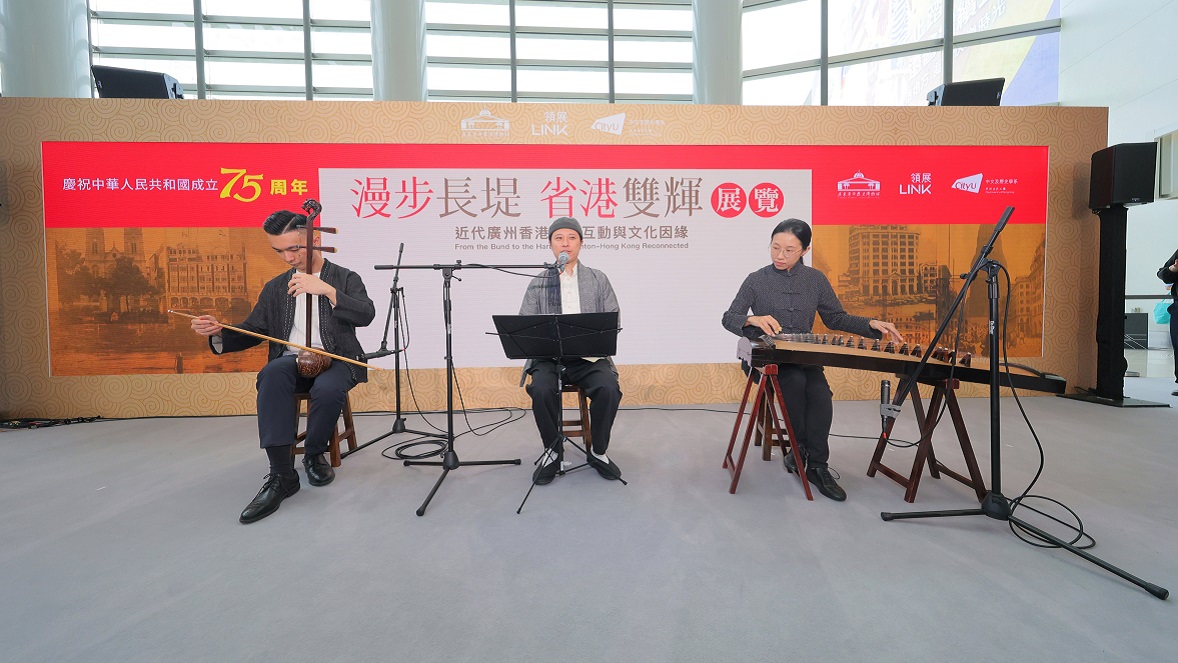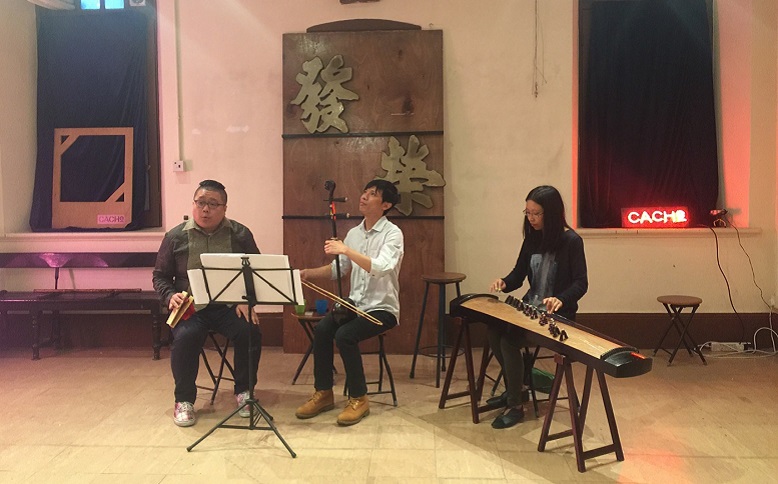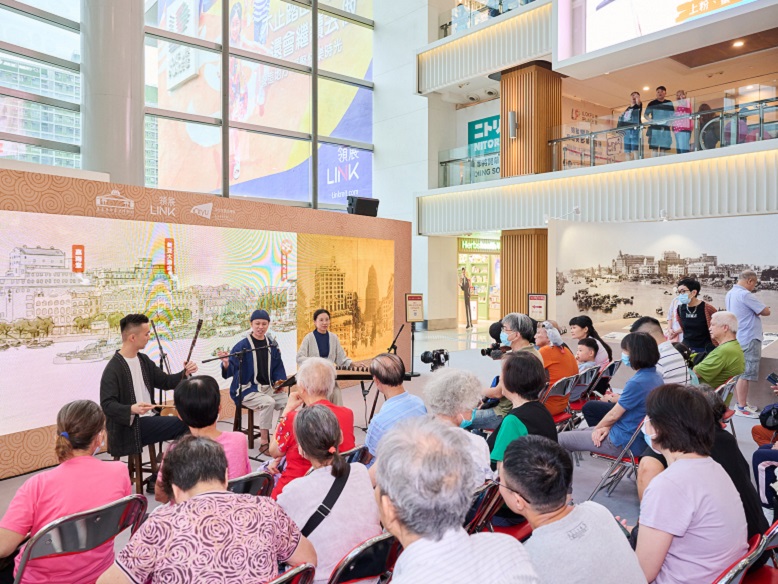
When you hear the term “narrative singing”, you might think of rap music, a central element of hip-hop culture that has captivated the world since its origination in the United States in the 1970s. However, did you know that Guangdong also has its own form of “narrative singing” – known as Naamyam, or “southern tunes”? While these two styles are musically distinct, they both draw inspiration from ordinary people and their experiences, offering a vibrant portrayal of society in all its diversity.
The exhibition From the Bund to the Harbour: Canton and Hong Kong Reconnected, which will open on 20 September, has invited The Gong Strikes One, a musical group that specialises in Cantonese opera music, to perform pop-up Naamyam shows at Lok Fu Place on select days. Channel 823 chatted with the group’s Kong Chan and King-chi Lee ahead of the exhibition, allowing them to lead you into the world of Naamyam and explore the enduring charm of this intangible cultural heritage of Hong Kong.
Channel 823: Where did the name “The Gong Strikes One” come from? What is the meaning behind it?"
The Gong Strikes One: The Chinese name, “Yat Choi Lo Gu”, literally means “one strike of the gong and drum”. It refers to a specific percussion pattern in Cantonese opera, often shortened to “Yat Choi” in scripts. Interestingly, its proper written form and pronunciation is “Yat Chui”, meaning “one mallet strike”. This pattern typically signals the start of every song or act in a performance, marked by a simultaneous strike of the gong and cymbals, creating a resounding “chaang” sound. Beyond its musical function, the name also carries auspicious connotations. It symbolises a successful opening night and a long run. For instance, the phrase “Yat Choi Lor Gu for ten shows” expresses the hope for a successful ten-show run.

Channel 823: What inspired the creation of “The Gong Strikes One”, and what are your main performance styles?
The Gong Strikes One: The two of us have been learning and playing musical instruments and experiencing Cantonese opera and Cantonese operatic songs since childhood. Initially, our group aimed to stage concerts showcasing Chinese opera music. We saw it as our way of promoting and spreading this traditional art form, introducing it to new audiences. As time went on, we started experimenting with theatrical performance styles, trying to highlight the unique musical qualities of Chinese opera.
Channel 823: In recent years, The Gong Strikes One has dedicated itself to using Naamyam to express the sentiments of Hong Kong communities. What sparked this decision?
The Gong Strikes One: From 2019 to 2022, we collaborated with the Intangible Cultural Heritage Office on a project called “Singing Naamyam as We Go”. We toured all 18 districts of Hong Kong, picking out a distinctive location in each district to perform new Naamyam lyrics crafted specially for that area or site. I still vividly recall our performance in the Wong Tai Sin district. Our performance venue was near the Wong Tai Sin Temple, right beside Link’s Temple Mall. The lyrics we wrote were closely related to the origins of Wong Tai Sin, and local residents listened with great interest. In the future, we hope to have the opportunity to perform in the Wong Tai Sin area again.

Channel 823: Why did you choose Naamyam for your performances at Lok Fu Place?
The Gong Strikes One: We were fortunate and honoured to be invited by Professor Ching May-bo, one of the curators of the From the Bund to the Harbour: Canton and Hong Kong Reconnected exhibition and a professor in the Department of Chinese and History at the City University of Hong Kong, to create new Naamyam lyrics inspired by the exhibition and perform them live.
As a traditional narrative singing style, Naamyam was originally used to share folk stories and everyday life experiences, and it remained popular in the Guangdong region until the early 20th Century. We believe that both the form of Naamyam and Naamyam itself are a perfect fit for this exhibition.
Channel 823: You mentioned creating new lyrics specifically for this exhibition. Can you tell us a bit about the general content?
The Gong Strikes One: We’ve centred the new lyrics around Guangzhou’s Changdi (a historic riverside road and once a bustling commercial hub) as it was in the early 20th Century. For us, lyrics must stem from genuine feelings. So, we arranged a four-day, three-night trip for on-site research. Before setting off, we read about the history of modern Guangzhou, looked at old photos and articles and drew inspiration from travel shows. Upon arrival, members from Guangdong Revolutionary History Museum, one of the exhibition organisers, explained the history of Changdi to us and took us on a tour. This experience deepened our understanding of the historical and cultural ties between Hong Kong and Canton. We will now channel our insights and imaginings of Changdi during that time into Naamyam lyrics to share with everyone.
Channel 823: What does The Gong Strikes One look forward to most from this performance?
The Gong Strikes One: It’s a rare opportunity to perform at Lok Fu Place for four Saturdays and Sundays in a row. We warmly invite everyone passing by to come and enjoy the music. For us as performers, it evokes a sense of nostalgia, taking us back to the old days of street busking. We hope the elderly can reminisce about the past through our performances while giving young people a glimpse of what it was like when Naamyam was performed on the streets.
In addition to new songs related to the exhibition, we will perform classic pieces like A Wanderer’s Autumn Grief. In some sessions, we also plan to sing a few lines of yueou (another singing style popular in Guangdong at the time, which is more melodious and prolonged than Naamyam). We hope everyone will come and support us!